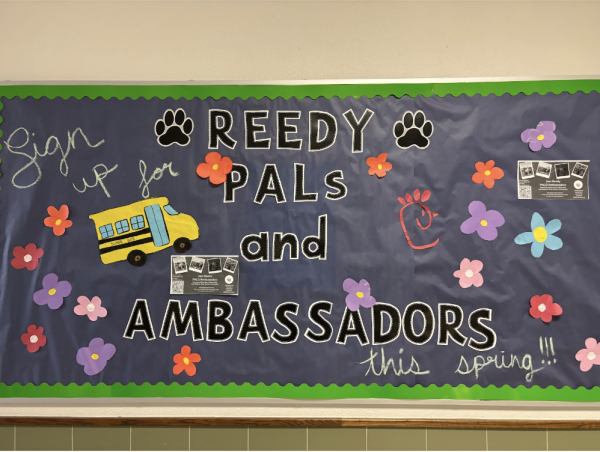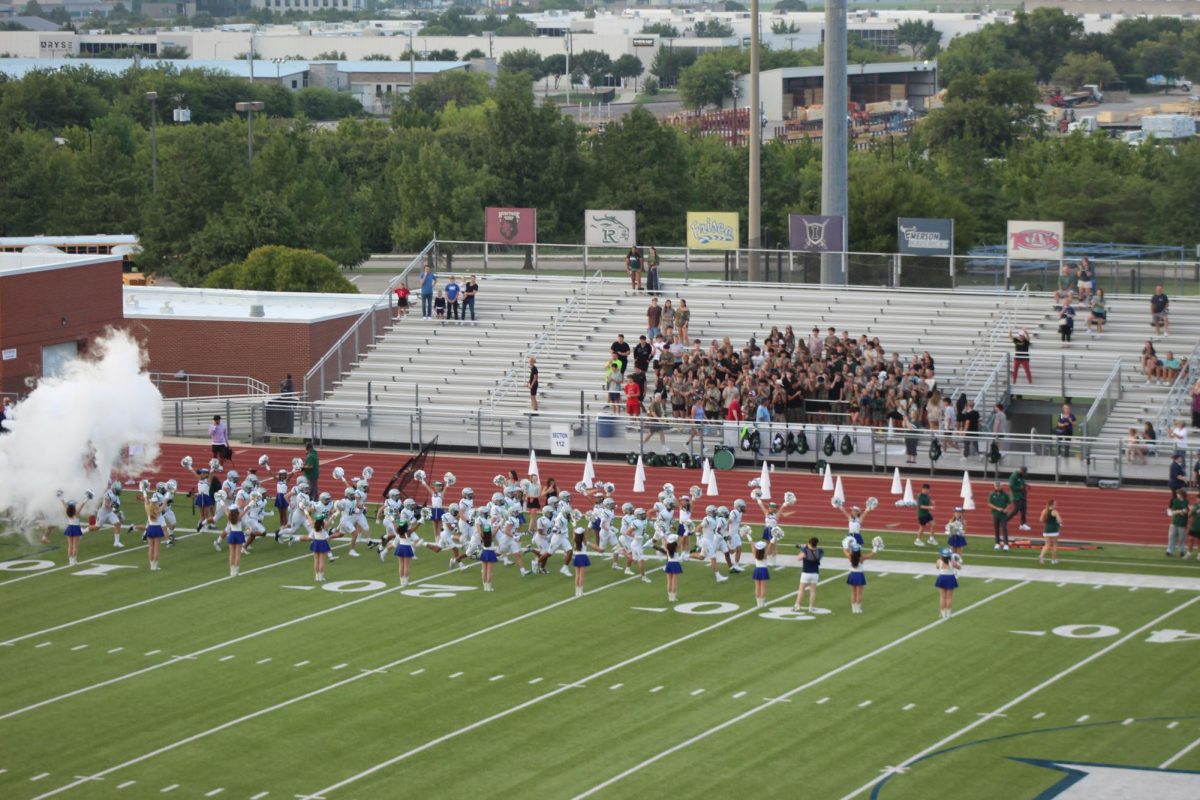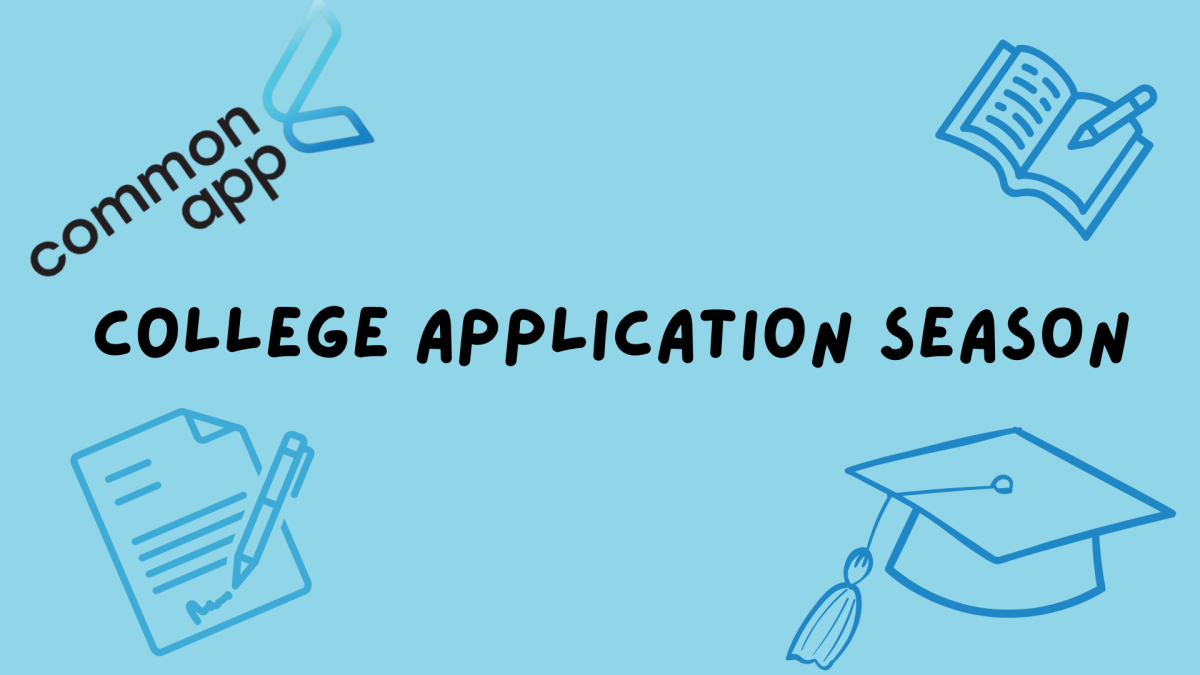
Campus Cornerstone
Relationships, managing stress, and growing up.
Those are just some parts of yesterday’s Pride Time lesson. Throughout the school year, the lessons were created by different schools in Frisco ISD. But this time it was different. It was no other than the representatives of our own campus, Reedy Ambassadors who made the lesson.
It was not just in Reedy, either. Twelve other schools in Frisco ISD attended the same Pride Time as well.
“We made the whole PowerPoint for the whole district,” Ambassador teacher Amanda Miller said.
Student-made Pride Time lessons may be familiar to current students, but the videos weren’t always created this way, according to counselor Jessia Sala. Just two years ago, it wasn’t the ambassadors who created the lessons.
“Two years ago, we were not always really great,” Sala said. “Sometimes they used old videos or kids would just tell us like ‘you are boring’ or ‘it’s not relevant’, and not just the topic, but the presentation wasn’t well done.”
Student Ambassadors’ responsibilities are not just about Pride Time lessons; they also participate in the Whole Child Committee. According to the Frisco ISD website, the committee works to promote a positive school climate that consists of parents, teachers, administrators, counselors, other school staff, and students.
“So there is a committee of adults, and we do have an ambassador come every time to give that student perspective, and also preview the lessons, they also go through the data, we would get these surveys instead of asking the whole staff, I can ask these ten people with different perspectives,” Sala said, who is also the part of the committee.
One of the ways the ambassadors contribute to the committee is helping them interpret data. At the beginning of every school year, the school conducts a safe-school survey to gather data about students’ perspective on safety. As part of the committee, student ambassadors would go through the data one by one.
“Then my kids sort through all that data, and then [associate principal] Mr. Bailey comes up with questions for them that he wants them to focus on,” Miller said. “So he puts a Google form together and I break them into groups… and they [ambassadors] go through all of the data and they pick out the questions that they thought were really good for Reedy, things we scored really high in, things we scored low in, things we think the school needs to work on.”
Once ambassadors give their ideas, committee supervisors, Sala and associate principal Bailey would take them to the administration.
“So between the two of us, it’s our job to then implement whatever we discuss,” Sala said.
Making Pride Time videos has been the responsibility of the counseling department, and they still make many non-district-wide videos. Students may have different opinions about the lessons, and Sala said she welcomes “constructive feedback”.
“I tell people all the time, I love to hear positive ideas,” Sala said. “Don’t just tell me something is terrible… I know that these lessons, especially when you’re a senior in high school, you’ve seen it all the way through high school and it gets boring, but they are relevant and I am just trying to find ways to make them better and more relevant and I always take any sort of construction feedback.”
The OpenDen team asked teachers to share their opinion about the Pride Time lessons. Some teachers gave some ideas about the topics.
“I think a big one for this campus in particular that would help that I don’t know that we talked about too much is just ‘perspective’,” geometry teacher Natalie Dominguez said. “Like people getting all freaked out about their grades, people are super intense about their grades, and I wish that they would just take a breath and keep perspective, not try to expect perfection out of themselves, because you’re not gonna be perfect.”
English II and GT Humanities teacher Staci Rogers also shared her opinion.
“I feel like the ones where students are most engaged is when they’re actually taking part in the conversation, where they’re doing things, whether they’re doing poles or quizzes and somehow interacting with it, making it more personal to them,” Rogers said.
Among many qualities, presenting student perspectives with confidence can be especially important for student ambassadors. According to Sala, it is something that the ambassadors are good at.
“I really enjoy working with Coach Miller and the kids that ambassadors have no issue telling you what they really think about things,” Sala said.
Speaking up the idea: to some student ambassadors, that is the number one advice.
“Don’t be afraid to speak up, even if it seems like your ideas might be bad or what not,” student ambassador Maxwell Van Cleave said. “Every idea counts, and maybe even that idea might be the best idea anyone’s ever thought of.”
Off-Campus Organization
Next year, the ambassador class will be combined with another leadership class: PAL, or Peer Assistant Leadership. Ambassadors create a positive school climate, while PALs develop peer mentoring, communication, and problem-solving skills, according to Frisco ISD course catalogue.
Unlike the Ambassadors, PALs reach out to other campuses, especially in elementary schools. According to Miller, who is also a teacher for PALs, the students go off-campus every class period to help elementary students who are in need.
“We go to all the ones [elementary schools] that lead to Reedy except for Nichols,” Miller said. “So we go to Vaughn, we go to Hosp, we go to Bledsoe and we go to Sparks. So the only one we don’t go to right now is Nichols,” Miller said.
Connecting with other people may be one of the most important parts of the class. Senior Halli Smith has been in PALs for two years. After moving in from Louisiana, the class helped her to build meaningful connections.
“I moved my sophomore year, a second semester and I met Coach Miller through her health class,” Smith said. “It was an overwhelming feeling, so I was happy for something new, but I also was set to leave a lot of my friends and family behind. The PAL program, it helped me build genuine connections, it helped me feel more included within the school, and it was just a great opportunity for me to get involved.”
The “genuine connection” was not just experienced by Smith; it is part of what it means to be in the class. PAL students build long-standing relationships with their “pals” in elementary school, who they regularly visit and give help. Miller shared the story when a little pal in elementary found her high school pal not coming back. At first she thought she was just absent. But she was not.
“When we said, ‘no, she’s not in high school anymore, so she can’t be her pal’, that little girl, like, was bawling,” Miller said. “She really loved her pal and she loved seeing her all the time and like the impact that we have on these kids. Vice versa, these kids have an impact on my students. One of my kids, her student, moved away over Christmas break. So when we went to the school, she went to pick up her pal, her pal was gone. She’s a senior, so she’s had that pal for two years, and she didn’t get to tell her goodbye, so my high school kid was crying. The connections that they make are phenomenal.”
Some bonds continue beyond the schools. One of Miller’s students is now in college. But even now, she is still in close contact with her old pal.
“I have a girl that graduated last year and every time she comes back, like she comes back for Christmas break and before she goes to school, she still goes and eats lunch with her pal who is still in elementary school. They still have a connection, even though she’s in college,” Miller said.
PALs have projects outside of elementary pals as well. Among many, donating over 150 costumes shone Halloween spirits in a children’s hospital called Children’s Health.
“[We had a project in which] people donated costumes for Halloween, and they all had to be brand new costumes. I think we got over 150 costumes donated, and then she took them to the children’s hospital, and so kids could dress up who were in the hospital and still have a Halloween.”
Another project was “Dancing with Dominic”, where the students volunteered at the Wonderfalls Family Festival 2024. The purpose was to help children with terminal disease, a condition which is expected to end in death.
“Dominic has a rare disease, a terminal disease,” Miller said. “He actually goes to school in Plano, but his mom reached out to us and we went to Rough Rider Stadium, and we decorated at two booths, and we handed out candy.”
Impact on Career
The PALs and Ambassador class offers unique lessons. One of the skills taught is leadership, and students may join a program called Chick-Fil-A Leadership Academy. Just as the name suggests, it is established and managed by Chick-Fil-A.
“One of the largest leadership-specific high school programs in America,” Chick-Fil-A Leadership Academy website says.
A part of the program is community service. According to Miller, the members in Reedy High School do four service projects throughout the year.
“My kids truly enjoy it,” Miller said. “For the past couple of years, during the end of the last school year, they did the student teacher basketball game. My kids are the ones that were putting them all together.”
Many students find the program helpful.
“Honestly, it’s a good program,” Van Cleave said. “You learn a lot from it and just like these leadership skills that you learn over time are gonna be really helpful later, and just really helpful later to improve the lifestyle of others and your workers and peers.”
Some students may find even deeper meaning than building life-long skills in the class: eating Chick-Fil-A sandwiches.
“Not that frequent, though, Like, twice a year,” Van Cleave said somewhat reluctantly.
The class can impact a larger career as well. According to Sala, it can be beneficial for pathways in education, business, psychology, and many more relating to social emotional states. In fact, many of the students are considering careers in those fields.
“I want to go into psychology,” Smith said. “So working with kids and seeing different people’s perspectives on things, it definitely will benefit me in the long run because whatever I do, I want to work with kids. This is a good experience to learn how to help others and also just be a better individual, not just helping others, but it helps you as an individual, and it helps you just grow.”
Smith wants to do one-on-one therapy after finishing her major, especially helping kids who have problems with mental health or any personal adversity. She said the PALs program connects to the job, and it helps a lot in general.
“For one, it’s a great opportunity to learn leadership skills, bonding with your peers and learning how to take the information and bring it to the real world, learning how to treat other people with respect, and ultimately giving kids somebody who they can talk to and who’s ready to hear them out and help them um grow up. These are the things that we teach them and the things that we do with them are things they’ll never forget as they move to middle school and high school and for the rest of their life. We teach them leadership skills and how to take ownership, how to take accountability, how to treat their peers and just be a better individual,” Smith said.
Future of the Leaders
The classes were not always like this, however. In the past, the Ambassadors was not a class, but rather an extracurricular. This school year is the first time Reedy has an Ambassador class.
“In the past, it was sort of just an outside of school activity, so we met during advisory times, once a month,” Sala said. “So all of the high schools now have a class period before ambassadors so that they have a dedicated time where they can all be there and they can all help with the different things instead of randomly pulling people in when they’re available during advisory.”
In addition to combining the two classes together, some other changes are anticipated next school year. For example, Miller plans to stop teaching her health class to focus on PALs and Ambassadors.
I would like to get four classes of PALs, not that I don’t want to teach health,” Miller said. “I love teaching health, but I’d like to get more students, I would say it that way. I’d like to get more students involved in the PALs program to where I can run four classes of pals and make it bigger than what it already is. I would like at least 120 kids in the program.”
PALs and Ambassadors classes had different changes in this and coming year. Ambassadors being an official class and combining with the PALs program were just some of them. According to Miller, more growth may be to come.
“We continue to grow each year,” Miller said. “PALs/Ambassadors will continue to grow through articles like this and other students spreading the word.”






